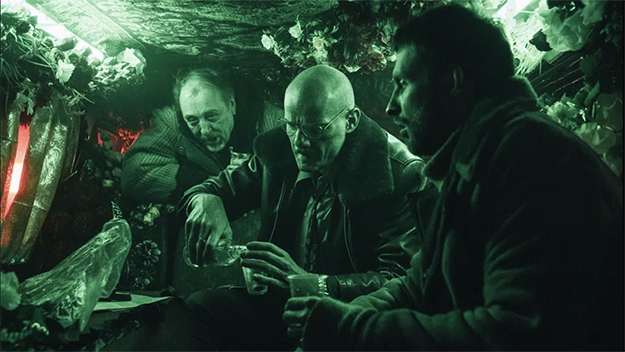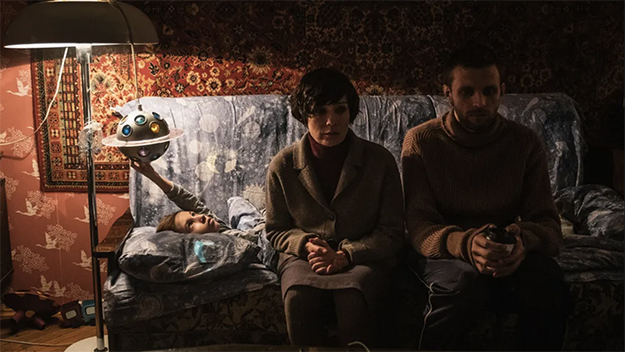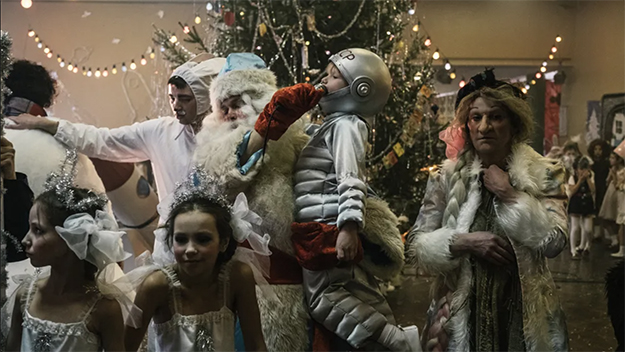Cannes Interview: Kirill Serebrennikov
This article appeared in the July 16 edition of The Film Comment Letter, our free weekly newsletter featuring original film criticism and writing. Sign up for the Letter here.

Petrov’s Flu (Kirill Serebrennikov, 2021)
Following a nearly 20-month house arrest on trumped-up embezzlement charges, embattled Russian director Kirill Serebrennikov has reemerged with a horrifying portrait of modern Russia from an artist who knows a thing or two about the government’s deleterious hold on his country’s collective psyche. Based on a novel by Alexey Salnikov, Petrov’s Flu—Serebrennikov’s eighth feature—follows the title character, a mechanic and moonlighting comic book artist played by Semyon Serzin, on a nocturnal journey through the dark heart of Moscow in which memories from his past and visions of his future collide in a slipstream of present-day anxieties. In the midst of a flu epidemic (the film was shot before COVID), a sickly Petrov, who we join in media res on an uncomfortably cramped bus of irritable locals, must navigate his way home through the streets to to his wife (Chulpan Khamatova) and young son (Vlad Semiletkov). Along the way, nauseous nightmares and real-world horrors manifest in surreal episodes of sex and death, street fights and firing squads, superhuman shows of strength and hallucinatory cosplay—to say nothing of an undead corpse that in this phantasmagorical narrative plays as a strange sort of comic relief.
Working with his regular cinematographer Vladislav Opelyants, Serebrennikov maps Petrov’s odyssey in a series of extended, relentlessly unfurling sequence shots that collapse time and push the feverish energy into a synesthetic realm unique to cinema. As exhausting as it is impressive, Petrov’s Flu plays in its best moments like a mad marriage of Aleksey German and the fiction films of Sergei Loznitsa—a far cry from the early ’80s musical nostalgia of Serebrennikov previous film, Leto (2018). In an era when filmmakers are often rewarded for following formulas in the name of fan service, Serebrennikov continues to draw valiantly outside the lines of what’s expected—not to mention, allowed—of an artist working under such hostile conditions.
Still unable to freely travel outside of Russia, Serebrennikov looked on from afar as Petrov’s Flu made its premiere earlier this week in the Cannes Competition. We caught up on Zoom during the festival to talk about the adaptation process, how his theater work has influenced his filmmaking, and turning challenges into adventures.
What was your initial impression of Salnikov’s book? I know your producer first brought it to your attention, but was it something you immediately thought could be made into a film?
In the beginning I had no idea what the book was about. I had just heard about it. Initially my producer, Ilya Stewart, asked me to write the script for someone else to direct, and I thought, “Okay, why not?” I had time. When I started to read it I understood that it’s some kind of masterpiece; it’s very rare in contemporary Russian literature when you immediately understand that something is of high value. And by that I mean the quality of the literature, the smell of the literature, how deep it is, its rigid form and different connections, links, and references within that form. And then of course the extraordinary language and exciting layers of different issues presented.
The structure of the book is really complicated. It’s much more complicated than the film because in the film I try to explain some things for the audience. The original is a really complex construction of past and present, with little that differentiates between the real and the imagined. Sometimes you can’t see where illusion starts and reality comes to an end. It’s just really complex, which made me think of how huge a challenge and task it would be for someone to make a film version of it. When you start doing things based on a book, adapting it for the screen, you normally need to find your own reason for doing it or your own vision of it. You need to enter somebody’s else’s dreams, and make them your dreams. This book has a lot of references to childhood, so I began thinking about my childhood and how I could tell some stories about it. I decided that it would be a challenge—both a practical challenge and a challenge of facing myself in the mirror of this amazing text.
Are we seeing more or less the narrative trajectory of the book play out on screen, or did you narrow the focus of the story?
It’s not really far from the book. It’s somehow close, because the book is really rich in terms of character, situations, everything—but it’s prose, it’s literature, it’s words on paper. When you start the adaptation process, you need to create your own universe. In our film, it’s completely artificial and kind of handmade, because the Russia of 2004, the Russia of 1976, and the Russia of the 1990s, they’re all quite difficult periods to build now, because life—the visuality of life—is changing really fast. Inside people’s minds it’s probably all the same, but visually it’s something different, so we had to create it [anew].
The film is set in Moscow, but we shot in Yekaterinburg, during the most terrifying winter. There wasn’t any snow. It was terrible because normally Russia is snowy—it’s a kind of normal weather condition. But this year there was no snow, and we had to cover the set with artificial snow. So there were different challenges—not really troubles, but adventures—during this film.
Tell me about the production process, specifically as it relates to the shooting. How freely are you able to make films? Do you have to work under the radar?
I was under arrest while writing the script. After I was released, we started to prepare and shoot the film. I shot somewhat covertly, and mainly at nighttime. All the actors agreed to shoot at night or sometimes early in the morning. But it was really fun: we prepared all these long takes that needed rehearsals, and I persuaded the producers that we had to collect all the extras—even the old people—in makeup, in costumes, to take the camera and do rehearsals without turning on the camera. For them it’s kind of stupid because it’s like, “Okay, why not shoot if you have the camera?” But I insisted and Ilya ultimately agreed that this was a good approach. All these takes needed to be prepared very carefully, very precisely, so it took time. The period of preparation was long, but we shot it in a very regimented manner. The schedule was really tough.
Petrov’s Flu (Kirill Serebrennikov, 2021)
Was the production in danger of being shut down at any point? Are the authorities watching what you do?
Nobody knows. We may know in 10 years, for instance, when we open the papers and learn they’ve been watching us. But you never know whether they follow you or what the big brother is thinking of you. We don’t care.
You mentioned the choreography. I imagine you storyboarded a lot of the film beforehand?
Sometimes we made little storyboard-like comics because the main character is an artist who draws comics, but other times we were improvising. For instance, in the film there’s a long 18-minute take. It’s the story of Sergei, the mediocre writer who kills himself; we prepared it in another location, but just before the shooting, like two days before, we found out they wouldn’t allow us to shoot there. Everything was already calculated: the take was supposed to be 13 minutes, but it grew to 18 minutes because the corridor where the scene is set was longer than the one at the original location. So in that instance we had to improvise.
I’m curious about the influence of theater in your work. I know that until recently you were the artistic director of the Gogol Center theater in Moscow.
Yes, I quit. I left that position this year, but I had been there for eight years.
Many of your films have a sort of theatrical sensibility, at least as it pertains to the staging and choreography. Can you talk about the relationship between the theater and cinema in your work?
Sometimes when I hear people say that there’s something theatrical in my work, I feel uncomfortable because, for me, it’s not really a good connotation. When I start to film, I try to get rid of everything connected with theater because it’s a completely different medium. For me it’s really far away—even the opposite. But of course theater has informed me, and it’s given me a certain experience of working with actors, for constructing the reality, for making this carnival. Because the book is very carnivalesque—it’s a very freaky, strange, crazy, delirious, almost limbo-like experience.
And of course theater also helped confirm my inclination to give seven roles to four actors. We had just five principal roles and a lot of small episodes, and I originally wanted to get good actors for each small episode. But it’s not in most actors’ interest to play nothing parts. So I decided, “Okay, you’ll play seven roles.” It was this that I think gave a lot of them the motivation to be part of the project. So that was probably a kind of theater approach. But mainly I prefer to construct and fix real life in front of the camera, and that’s the opposite of what I’m doing in theater.
Did you ever think that a film version of the book wouldn’t work, or that it would be better suited to the theater?
It’s an adventure, always, and sometimes it’s completely unpredictable. You don’t know what dark corner you’re going to end up in, or what problems or challenges you’ll encounter. So it’s an adventure, but I like jumping into an unknown space. I used to say that each film shoots itself. Film, like an animal or creature, chooses what it needs, what it wants, for living. And I am absolutely a person who believes in the fate of the film. If a film is huge, it wants to be huge. If it wants to be a chamber piece, then it will be a chamber piece. If a film needs this actor, this actor will be free. For instance, now I’m working on a new film, and I have an episode that I was hesitant about. I wasn’t sure if it was necessary or not, but I left it in and decided that we could just fix it in the edit if we couldn’t find the right actor for the scene. Then we found a guy who told us, “Okay, I’m free. I’m happy to do it.” And then he broke his leg! It was then that I understood that the film doesn’t want this episode. So I cut it out.
I’m curious about your interest in animation. Of course the main character in this film is an artist, but there’s been animation and onscreen graphics in most of your recent movies.
It’s true, I’ve used animation in previous films. Initially for this one I was thinking of using some small cartoon animations or something like that, but eventually I realized that the whole thing is like a living comic. All around this character is a very smelly reality—so the animation for me comes forth from this reality, and these characters.
Petrov’s Flu (Kirill Serebrennikov, 2021)
Can you tell me a little about working with your cinematographer? Were the long takes written into the script, and how did he feel about executing these sequences?
Normally it’s like I’m playing a crazy trick on my cameraman. I’m saying, “Look, scenes number 3, 4, 5, and 6 will be in one take.” And they say, “What? That’s not possible.” But I say, “Let’s try to do our best.” I always try to make challenges for myself and my collaborators. I’ve worked with this team for a few projects now. We started with The Student (2016), which played in Un Certain Regard, and we continued with Leto, a summer movie about the rock club in Leningrad in the Soviet period. And now we know each other better. They know me and they know what kind surprises to expect; they’re waiting for some tricks from me. I think there should always be something difficult to work through on set. Otherwise, it’s not interesting. It was actually my team that suggested we start production with the 18-minute sequence. I said, “Okay, yes, it will be team-building!” [Laughs] And it really was team-building, because after the scene they told me, “Okay, now we’re not afraid of anything. Nothing can scare us.”
What can you tell me about the guy who plays the corpse [Husky]? From what I gather he’s an artist of some sort?
He’s a rapper, a Russian rap singer. He’s a friend of mine. I adore his poetry. He participated in my stage version of a work by our famous 19th-century poet Alexander Pushkin. I think that rappers are in the same lineage as famous Russian writers. So I invited him to take part in this production. He’s a good guy with a strange appearance and very freaky features and behavior. For a long time, he had no phone. Not many people are on his wavelength. So I told him, “I have a very strange part for you. You’ll be a corpse. You’ll lay in the coffin but at the very end you’ll stand up and sing this song and it’ll all be done in one long take.” And he said, “Okay, no problem.” So we made the end of the movie into a kind of zombie apocalypse musical. It was a great pleasure, for me as well as him. With pleasure, he laid in the coffin for a while.
You mentioned you’re working on a new film. What keeps you inspired and motivated when so many forces seem intent on keeping you down?
Well, as you know, I can’t leave Russia right now. I have a travel ban. So what do I do? I work. If you start thinking negatively you’ll destroy yourself. I hope that all of this will eventually come to an end, and that I’ll be free to travel with my friends and decide what to do in the next part of my life.
Jordan Cronk is a film critic and founder of the Acropolis Cinema screening series in Los Angeles. His writing has appeared in Artforum, Cinema Scope, frieze, the Los Angeles Review of Books, Sight & Sound, and more. He is a member of the Los Angeles Film Critics Association.









